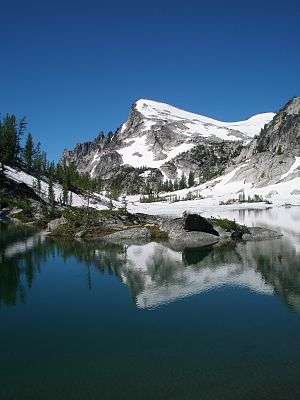Little Annapurna
Little Annapurna[2] is an 8,440+ ft granite summit located in Chelan County of Washington state. The origin of the name came from the Sherpa Climbing Club of Ellensburg, and is inspired by the obvious resemblance to its Himalayan namesake when comparing the south faces of both.[3][4] Little Annapurna is part of The Enchantments within the Alpine Lakes Wilderness, and is set on land managed by Okanogan-Wenatchee National Forest. It belongs to the Stuart Range which is subset of the Cascade Range. Little Annapurna is situated southeast of Dragontail Peak, which is its nearest higher neighbor.[1] Remnants of the receding Snow Creek Glacier can be found on its gentle north slope. Precipitation runoff drains into tributaries of the Wenatchee River.
| Little Annapurna | |
|---|---|
 Little Annapurna from Rune Lake | |
| Highest point | |
| Elevation | 8,440 ft (2,570 m) [1] |
| Prominence | 280 ft (85 m) [1] |
| Coordinates | 47°28′06″N 120°48′52″W [1] |
| Geography | |
 Little Annapurna Location in Washington  Little Annapurna Location in the United States | |
| Location | Chelan County, Washington state, U.S. |
| Parent range | Cascade Range Wenatchee Mountains Stuart Range |
| Topo map | USGS Enchantment Lakes |
| Geology | |
| Type of rock | Granite |
| Climbing | |
| Easiest route | Scrambling class 2 |
Climate
Most weather fronts originate in the Pacific Ocean, and travel east toward the Cascade Mountains. As fronts approach, they are forced upward by the peaks of the Cascade Range, causing them to drop their moisture in the form of rain or snowfall onto the Cascades (Orographic lift). As a result, the Cascades experience high precipitation, especially during the winter months in the form of snowfall. During winter months, weather is usually cloudy, but, due to high pressure systems over the Pacific Ocean that intensify during summer months, there is often little or no cloud cover during the summer.[3] Because of maritime influence, snow tends to be wet and heavy, resulting in high avalanche danger.[3]
Geology
The Alpine Lakes Wilderness features some of the most rugged topography in the Cascade Range with craggy peaks and ridges, deep glacial valleys, and granite walls spotted with over 700 mountain lakes.[5] Geological events occurring many years ago created the diverse topography and drastic elevation changes over the Cascade Range leading to the various climate differences.
The history of the formation of the Cascade Mountains dates back millions of years ago to the late Eocene Epoch.[6] With the North American Plate overriding the Pacific Plate, episodes of volcanic igneous activity persisted.[6] In addition, small fragments of the oceanic and continental lithosphere called terranes created the North Cascades about 50 million years ago.[6]
During the Pleistocene period dating back over two million years ago, glaciation advancing and retreating repeatedly scoured the landscape leaving deposits of rock debris.[6] The last glacial retreat in the Alpine Lakes area began about 14,000 years ago and was north of the Canada–US border by 10,000 years ago.[6] The "U"-shaped cross section of the river valleys are a result of that recent glaciation. Uplift and faulting in combination with glaciation have been the dominant processes which have created the tall peaks and deep valleys of the Alpine Lakes Wilderness area.
References
- "Little Annapurna, Washington". Peakbagger.com.
- "Little Annapurna". Geographic Names Information System. United States Geological Survey. Retrieved 2018-08-02.
- Beckey, Fred W. Cascade Alpine Guide, Climbing and High Routes. Seattle, WA: Mountaineers Books, 2008.
- Barnes, Nathan and Jeremy, Alpine Lakes Wilderness: The Complete Hiking Guide, Mountaineers Books. 2019.
- Smoot, Jeff (2004). Backpacking Washington’s Alpine Lakes Wilderness. Helena, Montana: The Globe Pequot Press.
- Kruckeberg, Arthur (1991). The Natural History of Puget Sound Country. University of Washington Press.
External links
| Wikimedia Commons has media related to Little Annapurna. |
- Weather forecast: Little Annapurna
- Alpine Lakes Wilderness (Wenatchee National Forest) U.S. Forest Service
- Little Annapurna aerial photo: PBase.com